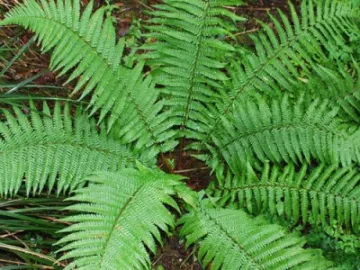Usually my pieces for TarvinOnLine are about plants with colourful flowers or berries – but today's is different.
I am going to talk about some of our very green but non-flowering plants that are classed as Pteridophytes (pronounced Ter-rid-O-fights) – a group that is made up predominantly of ferns. The total number of different ferns that exist is enormous but, in our woodland, there are just two types that predominate.
These are Bracken (Pteridium aquilinum) and the Male Sheild Fern (Dryopteris Filix-Mas).
{Photos illustrating the 2 types of fern are at the end of the article- click them to enlarge
}
Let's look at their similarities first.
Being non-flowering doesn't mean that ferns have no involvement with sexes – far from it. But they DO have two stages to their reproductive cycle, with only one of them -the non-sexy one -being visible to us.
When we see large, feathery fronds with tiny brown spots on their under-side, we are looking at the stage in the plant's life cycle that does not involve sexes. The spots on the frond's under-side (called sporangia) are the source of spores which can be carried by air or water and will germinate elsewhere. Each cell of the spores is provided with only half of the chromosomes needed to make another large plant and, when it germinates in a damp place, it forms a tiny body (called a prothallus) with some parts that are male (and can produce sperms) and other parts that are female (and will produce eggs).
Because the spore carried only half the necessary chromosomes for the adult stage, then the eggs and sperms can each have only half of the full number.
When the sperms, swimming in the dampness, reach and fertilise an egg, then the full number of chromosomes will be restored in the fertilised cell and an adult fern will then begin to grow out of the prothallus and will form the large generation that we CAN see – thereby completing a rather complicated life cycle.
Next, we come to the differences. From an evolutionary point of view, bracken is one of the most successful of the ferns. It is typically found in moorland environments, similar to heather, and is referred to by some locals in the north of England as 'Moorland Scrub'.
It loves to grow out in full sunshine, sending up large, triangular, branching fronds (up to 2 metres / 6'6'' tall) from a tough, wide-creeping underground rootstock (rhizome) that can travel between fronds for a metre or more underground.
In this way, it forms very dense, spreading thickets, and it is this behaviour that leads to bracken being considered a pernicious, invasive and opportunistic plant. It will take over from all of the plants traditionally associated with open moorland and will also seriously reduce ease of access by humans.
It is poisonous to cattle, dogs, sheep, pigs and horses and is linked to cancers in humans. On top of all this, it can harbour high levels of sheep ticks, which can pass on Lyme disease. Global climatic changes have suited bracken well and have contributed to its rapid increase in land coverage.
Evidently, this is not a plant that we are pleased to have in our woodland – and yet, in the 'newer', Saxon Heath section, it is there aplenty!
Compare, on the other hand, the Male Shield Fern. This fern's spore-bearing stage is as a separate (and very definitely non-spreading) plant, with just a single crown on each rootstock. Each of the un-branched and very graceful fronds grows upright from the stout and erect rootstock (rhizome) to a height of about 1.5 metres (5'). The fronds turn coppery-brown in the autumn, dying back to re-grow in the spring.
It is a plant which harbours neither pests nor diseases and it enjoys growing in very shady, damp areas of the woodland.
The Male Shield Fern is infinitely to be preferred to its thuggish cousin, Bracken.
Clearly, it is important to be able to tell these two apart – particularly since the safety of bracken is questionable. The easiest way is to look at the fronds. Do the fronds grow un-branching, directly from the rhizome at ground level? If so, you are looking at the Shield Fern, which is absolutely safe (and should definitely be encouraged.) However, if the centre stem of the frond itself has smaller fronds branching out of it, then this is bracken – definitely best avoided!
Bracken is so much of a thug wherever it grows – and especially in our woodland -that it really does have to be controlled. In addition to safety issues, removing bracken encourages the original habitats to re-establish, and these are of much greater importance for wildlife. Deciding upon methods by means of which it can be controlled is a difficult business – management is actually both problematic and expensive, so that, ultimately, any plans may need to be about cost-effective, practical limitation and control rather than seeking a means by which we might rapidly eradicate it.
A lengthy "war of attrition" may turn out to be our best answer!
These are photos of the 2 types of ferns
Bracken with Branching FrondsIMG(506138,S,L,1)Bracken SwampingHedgeIMG(506141,S,R,1)
Dryopteris FernIMG(506139,S,L,1) Dryopteris Fern unbranched fronds 
Quick Links
Get In Touch
TarvinOnline is powered by our active community.
Please send us your news and views.







